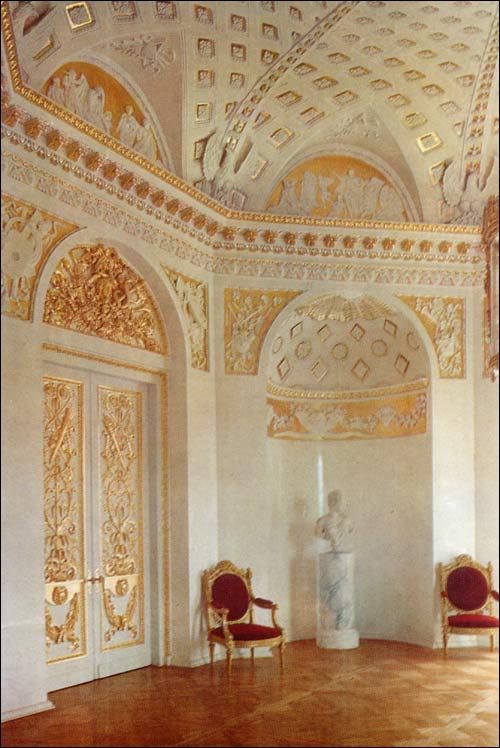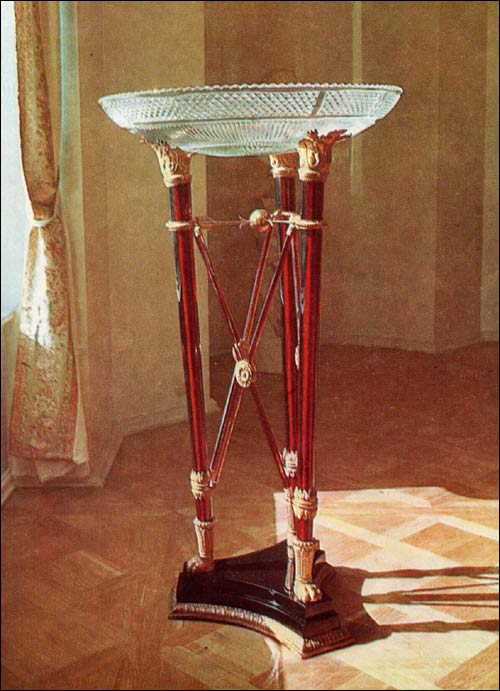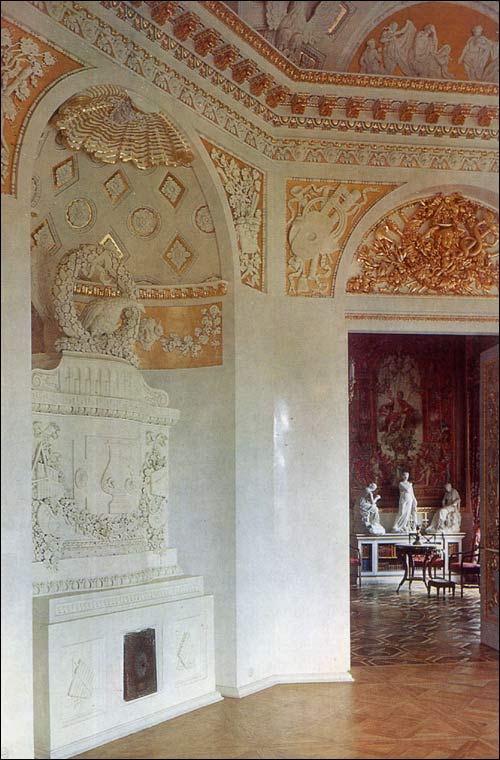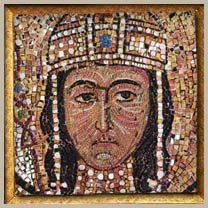In the upper gallery of Hagia Sophia, in the special area reserved for the clergy, is this famous mosaic of the great Byzantine Emperor and his family - learn more .

|


The Hall of Peace, decorated by Brenna, repeats the layout and general architectural forms of the Hall of War, but is the latter's exact opposite in the motifs of its decor. It is ornamented with emblems of the arts, farming implements, sheaves of grain, basketfuls of flowers or fruit, musical instruments, clusters of grapes, cornucopias, etc.; in other words, attributes typical of the eighteenth-century cult of nature and idealization of rural life, and associated with the idea of peace.
The ornamental pattern of the carved and gilded doors includes a Cupid's bow and a quiver with arrows, the emblems of love. The stove is surmounted by the figure of a peacock (symbol of conjugal fidelity and friendship), and adorned with a lyre, wreaths of wild flowers, and musical instruments suspended from bows. The Hall of Peace opens the suite of state apartments belonging to the Empress Maria Feodorovna. Originally meant to be a state drawing-room, during Paul I's reign it served as the Empress's Presence Chamber, and a Chair of State was installed there, upholstered with silver-embroidered velvet, like the Emperor's in the Hall of War. Antique marble busts of Roman empresses and noblewomen (first - second century) were placed in the niches. The splendour of the hall was accentuated by bronze candelabra on tall gueridons, made in France. After the fire of 1803 Voronikhin built here a ceiling imitating a vault and ornamented with moulded coffering, replacing the ruined paintings of Brenna. Voronikhin's bas-reliefs present mythological scenes centering around women. The only note of discord in the generally peaceful decor of this hall is struck by the figures of eagles on the cornice, which, though clutching flowers instead of thunderbolts, are still a symbol of might and greatness. In 1809 here, as in the Hall of War, was placed a large Athenienne, a decorative tazza on a tripod stand, fashioned from Voronikhin's sketches at the St Petersburg Imperial Glass House (the Athenienne in the Hall of War was destroyed by nazi soldiers during the War of 1941-45). Modelled on the bronze altar of classical antiquity, it has a shallow bowl of cut crystal and amber-coloured legs of topaz glass. The Athenienne stands in front of the large plate-glass window, and the play of sunlight on its crystal facets reveals in full measure the beauty of the material and the excellence of the workmanship. Similar Atheniennes with legs of blue crystal adorn the console tables in the Pilaster Room. At each end of the suite consisting of the three state apartments - the Hall of War, the Grecian Hall and the Hall of Peace - stands a large porcelain vase in underglaze blue, With delicately chased ormolu handles. The classical form of the vases, their beautiful colouring and the fine gold tracery woven over the surface, are all distinctive features by which we identify Sevres porcelain. The vases had been made for Napoleon who, according to tradition, presented them to Alexander I as a diplomatic gesture, when the two emperors met at Tilsit. Equally perfect examples of French craftsmanship are the pair of ormolu lanterns hung, one each, in the Hall of Peace and the Hall of War. Judging by the general character of the design, by the delicacy of the chasing and the excellent quality of gilding, they may well have come from the workshop of Pierre Gouthiere.    |

|





